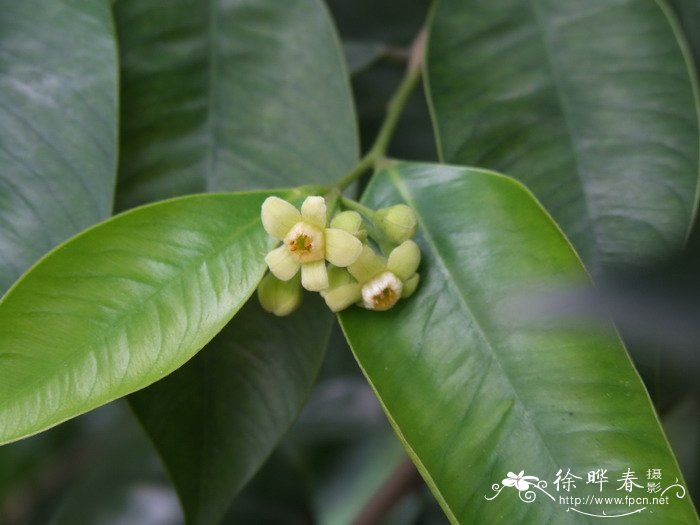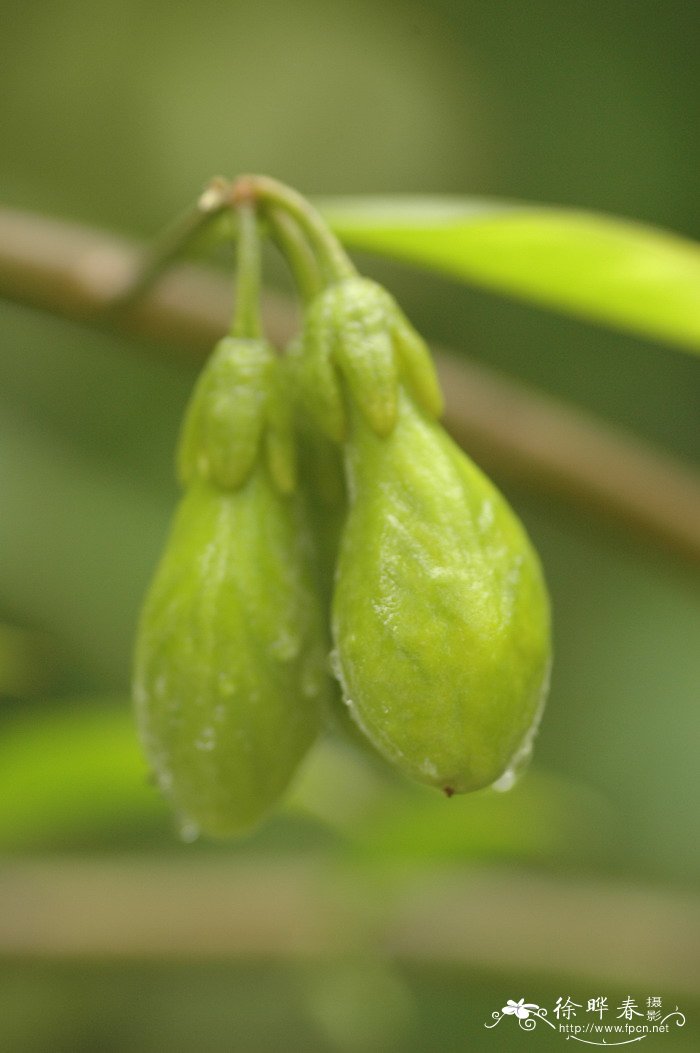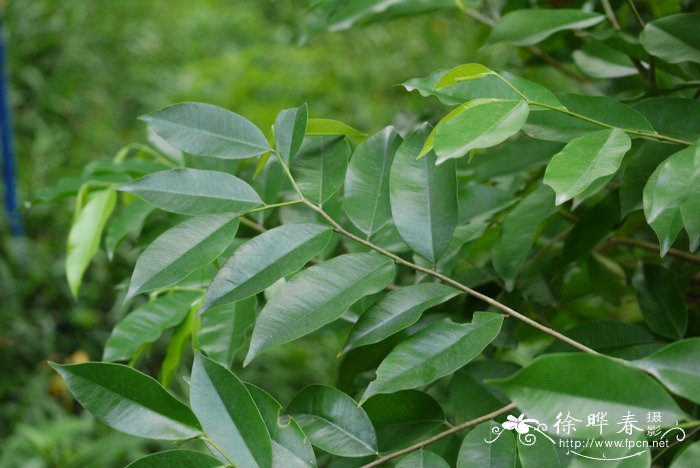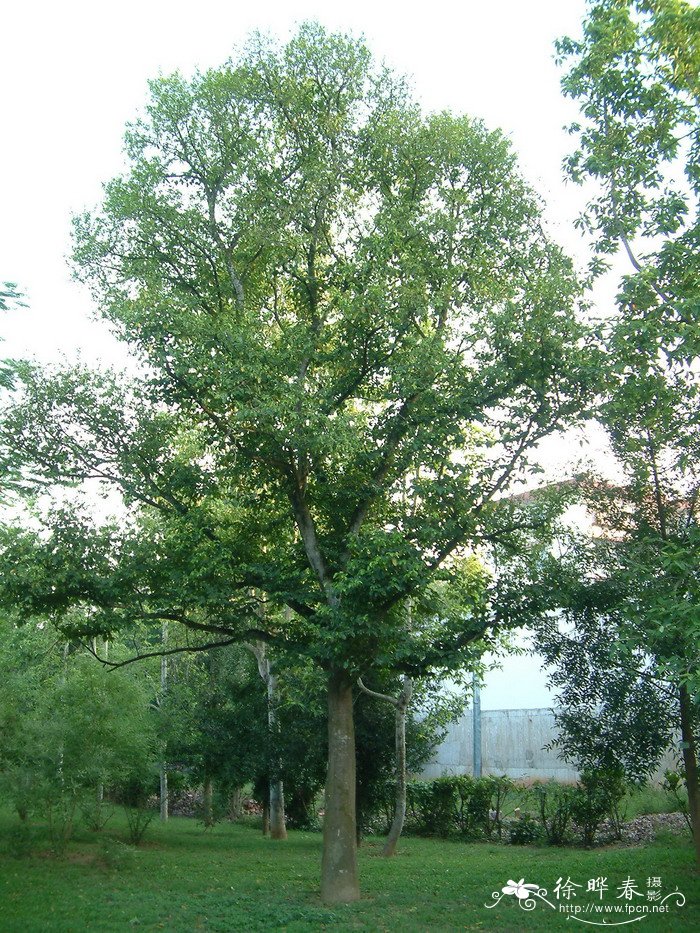土沉香Aquilaria sinensis
中文名(Chinese Name):土沉香
学名(Scientific Name):Aquilaria sinensis (Lour.) Spreng.
英文名(English Common Name):
别名(Chinese Common Name):白木香
异名(Synonym):Agallochum sinense Kuntze Aquilaria grandiflora Benth. Aquilaria ophispermum Poir. Ophiospermum sinense Lour. Agallochum grandiflorum (Benth.) Kuntze Aquilaria chinensis Spreng. Ophispermum sinense Lour.
科属(Family & Genus):瑞香科(Thymelaeaceae)沉香属
形态特征(Description):乔木,高5-15米,树皮暗灰色,几平滑,纤维坚韧;小枝圆柱形,具绉纹,幼时被疏柔毛,后逐渐脱落,无毛或近无毛。叶革质,圆形、椭圆形至长圆形,有时近倒卵形,长5-9厘米,宽2.8-6厘米,先端锐尖或急尖而具短尖头,基部宽楔形,上面暗绿色或紫绿色,光亮,下面淡绿色,两面均无毛,侧脉每边15-20,在下面更明显,小脉纤细,近平行,不明显,边缘有时被稀疏的柔毛;叶柄长约5-7毫米,被毛。花芳香,黄绿色,多朵,组成伞形花序;花梗长5-6毫米,密被黄灰色短柔毛;萼筒浅钟状,长5-6毫米,两面均密被短柔毛,5裂,裂片卵形,长4-5毫米,先端圆钝或急尖,两面被短柔毛;花瓣10,鳞片状,着生于花萼筒喉部,密被毛;雄蕊10,排成1轮,花丝长约1毫米,花药长圆形,长约4毫米;子房卵形,密被灰白色毛,2室,每室1胚珠,花柱极短或无,柱头头状。蒴果果梗短,卵球形,幼时绿色,长2-3厘米,直径约2厘米,顶端具短尖头,基部渐狭,密被黄色短柔毛,2瓣裂,2室,每室具有1种子,种子褐色,卵球形,长约1厘米,宽约5.5毫米,疏被柔毛,基部具有附属体,附属体长约1.5厘米,上端宽扁,宽约4毫米,下端成柄状。花期春夏,果期夏秋。
分布(Distribution):产广东、海南、广西、福建,生低海拔的山地、丘陵以及路边阳处疏林中。
用途(Use):老茎受伤后所积得的树脂,俗称沉香,可作香料原料,并为治胃病特效药;树皮纤维柔韧,色白而细致可做高级纸原料及人造棉;木质部可提取芳香油,花可制浸膏。
引自中国植物志英文版:FOC Vol. 13 Page 214, 215
Aquilaria sinensis (Loureiro) Sprengel, Syst. Veg. 2: 356. 1825.
土沉香 tu chen xiang | Thymelaeaceae | Aquilaria
Ophispermum sinense Loureiro, Fl. Cochinch. 1: 281. 1790; Agallochum sinense (Loureiro) Kuntze; Aquilaria grandiflora Bentham; A. ophispermum Poiret.
Trees 5-15 m tall. Bark dark gray, smooth; branchlets terete, rugose, puberulous, glabrescent. Petiole 5-7 mm, pubescent; leaf blade dark or purple-green, glossy adaxially, light green abaxially, orbicular or elliptic to oblong, sometimes obovate, 5-9 × 2.8-6 cm, leathery, both surfaces glabrous, but sometimes puberulous along margin, base broadly cuneate, apex acuminate or acute, apiculate; lateral veins 15-20 pairs, more conspicuous abaxially, veins and veinlets slender, subparallel, obscure. Inflorescence terminal, a loose panicle of umbels, many flowered. Flowers fragrant at night; pedicel 5-10 mm, densely yellow-gray pubescent. Calyx yellowish green; tube narrowly campanulate, 5-6 mm, exterior and interior densely pubescent; lobes 5, ovate, 3-5 mm, both surfaces pubescent, apex rounded and obtuse, or acute. Petaloid appendages 10, scalelike, inserted at throat of tube, obviously densely pilose at anthesis. Stamens 10; filaments ca. 1 mm; anthers linear-oblong, ca. 1.5 mm. Ovary ovoid, densely grayish white hairy; style obsolete or nearly so; stigma capitate. Capsule shortly stipitate, ovoid, 2-3 × ca. 2 cm, densely yellow pubescent, base tapering, apex apiculate; pericarp thin, smooth when dried. Seeds dark brown, ovoid, ca. 10 × 7.5 mm, white sericeous or glabrous; funicle conspicuous, ca. 1.5 × 0.4 cm, longer than seed, tapered at base, broad and compressed below seed. Fl. spring-summer, fr. summer-autumn.
● Lowland forests, sunny places on slopes or along roadsides. Fujian, Guangdong, Guangxi, Hainan.
Aquilaria sinensis has been very heavily exploited and is listed as vulnerable by the IUCN. The bark is used to make paper; the heart wood is prized for its fragrance.




(责任编辑:徐晔春)
学名(Scientific Name):Aquilaria sinensis (Lour.) Spreng.
英文名(English Common Name):
别名(Chinese Common Name):白木香
异名(Synonym):Agallochum sinense Kuntze Aquilaria grandiflora Benth. Aquilaria ophispermum Poir. Ophiospermum sinense Lour. Agallochum grandiflorum (Benth.) Kuntze Aquilaria chinensis Spreng. Ophispermum sinense Lour.
科属(Family & Genus):瑞香科(Thymelaeaceae)沉香属
形态特征(Description):乔木,高5-15米,树皮暗灰色,几平滑,纤维坚韧;小枝圆柱形,具绉纹,幼时被疏柔毛,后逐渐脱落,无毛或近无毛。叶革质,圆形、椭圆形至长圆形,有时近倒卵形,长5-9厘米,宽2.8-6厘米,先端锐尖或急尖而具短尖头,基部宽楔形,上面暗绿色或紫绿色,光亮,下面淡绿色,两面均无毛,侧脉每边15-20,在下面更明显,小脉纤细,近平行,不明显,边缘有时被稀疏的柔毛;叶柄长约5-7毫米,被毛。花芳香,黄绿色,多朵,组成伞形花序;花梗长5-6毫米,密被黄灰色短柔毛;萼筒浅钟状,长5-6毫米,两面均密被短柔毛,5裂,裂片卵形,长4-5毫米,先端圆钝或急尖,两面被短柔毛;花瓣10,鳞片状,着生于花萼筒喉部,密被毛;雄蕊10,排成1轮,花丝长约1毫米,花药长圆形,长约4毫米;子房卵形,密被灰白色毛,2室,每室1胚珠,花柱极短或无,柱头头状。蒴果果梗短,卵球形,幼时绿色,长2-3厘米,直径约2厘米,顶端具短尖头,基部渐狭,密被黄色短柔毛,2瓣裂,2室,每室具有1种子,种子褐色,卵球形,长约1厘米,宽约5.5毫米,疏被柔毛,基部具有附属体,附属体长约1.5厘米,上端宽扁,宽约4毫米,下端成柄状。花期春夏,果期夏秋。
分布(Distribution):产广东、海南、广西、福建,生低海拔的山地、丘陵以及路边阳处疏林中。
用途(Use):老茎受伤后所积得的树脂,俗称沉香,可作香料原料,并为治胃病特效药;树皮纤维柔韧,色白而细致可做高级纸原料及人造棉;木质部可提取芳香油,花可制浸膏。
引自中国植物志英文版:FOC Vol. 13 Page 214, 215
Aquilaria sinensis (Loureiro) Sprengel, Syst. Veg. 2: 356. 1825.
土沉香 tu chen xiang | Thymelaeaceae | Aquilaria
Ophispermum sinense Loureiro, Fl. Cochinch. 1: 281. 1790; Agallochum sinense (Loureiro) Kuntze; Aquilaria grandiflora Bentham; A. ophispermum Poiret.
Trees 5-15 m tall. Bark dark gray, smooth; branchlets terete, rugose, puberulous, glabrescent. Petiole 5-7 mm, pubescent; leaf blade dark or purple-green, glossy adaxially, light green abaxially, orbicular or elliptic to oblong, sometimes obovate, 5-9 × 2.8-6 cm, leathery, both surfaces glabrous, but sometimes puberulous along margin, base broadly cuneate, apex acuminate or acute, apiculate; lateral veins 15-20 pairs, more conspicuous abaxially, veins and veinlets slender, subparallel, obscure. Inflorescence terminal, a loose panicle of umbels, many flowered. Flowers fragrant at night; pedicel 5-10 mm, densely yellow-gray pubescent. Calyx yellowish green; tube narrowly campanulate, 5-6 mm, exterior and interior densely pubescent; lobes 5, ovate, 3-5 mm, both surfaces pubescent, apex rounded and obtuse, or acute. Petaloid appendages 10, scalelike, inserted at throat of tube, obviously densely pilose at anthesis. Stamens 10; filaments ca. 1 mm; anthers linear-oblong, ca. 1.5 mm. Ovary ovoid, densely grayish white hairy; style obsolete or nearly so; stigma capitate. Capsule shortly stipitate, ovoid, 2-3 × ca. 2 cm, densely yellow pubescent, base tapering, apex apiculate; pericarp thin, smooth when dried. Seeds dark brown, ovoid, ca. 10 × 7.5 mm, white sericeous or glabrous; funicle conspicuous, ca. 1.5 × 0.4 cm, longer than seed, tapered at base, broad and compressed below seed. Fl. spring-summer, fr. summer-autumn.
● Lowland forests, sunny places on slopes or along roadsides. Fujian, Guangdong, Guangxi, Hainan.
Aquilaria sinensis has been very heavily exploited and is listed as vulnerable by the IUCN. The bark is used to make paper; the heart wood is prized for its fragrance.
(责任编辑:徐晔春)
踩一下[0]

顶一下[6]